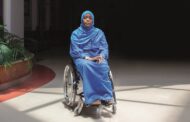A collage image displayed at a school in Ukraine (image from 2019)
By Su Lyn Corcoran, Helen Pinnock and Rachel Twigg
Inclusive education acknowledges that learners have a ‘right to belong’ within both school and home communities.in this article, we explore the importance of home-school connections, using findings from a home learning survey conducted in 2020 during the height of the COVID-19 pandemic. Focusing on responses from
Ukraine, we highlight how existing support networks and effective home-school relationships led to better outcomes for children learning at home during a crisis.
Teacher-parent partnerships
Parental involvement in and attitudes towards learning, academic achievement and socio-emotional development influence children’s attitudes to learning. Relationships between parents and teachers, and between communities and schools, are critical to facilitating positive parental roles. High- quality links, welcoming environments, and
partnering activities help parents and teachers work together to support children’s wellbeing and intellectual development. Learners with disabilities and/or additional needs often need more attention and greater advocacy from parents to ensure they are included in learning. School-home partnerships are central to meeting their child development goals.
The importance of teacher-parent partnerships is well understood, but in many contexts teachers see parents as an inconvenience. Many school systems were therefore unprepared for changing parents’ roles when COVID-19 closed schools and children had to learn at home. We also noticed that most home learning materials and activities provided at this time had little or no focus on the needs of learners with disabilities, or on learners’, parents’, and teachers’ mental health and wellbeing.
Our survey
In response to the crisis, EENET and Norwegian Association of Disabled (NAD) developed some basic home learning guidance materials for families of children with disabilities. To inform the materials we conducted an online survey in 14 languages. We received 944 responses from Ukraine, providing a snapshot of the home learning support provided during the first six months of the pandemic. Much of the infrastructure described by Ukrainian respondents has now been damaged, destroyed, or otherwise negatively impacted by the current war, but the respondents gave their time to share their experiences and we wish to acknowledge that. And, as the authors of the latest Ukraine case studies in this edition suggest, their experiences during COVID-19 have helped them adapt to the current situation.
Findings – the challenges
Centralized support for home learning in Ukraine was provided through the Ministry of Education YouTube channel and 11 television channels. Schools and other education centres provided additional support through printed study materials or remote teaching sessions using the phone, online platforms and social media groups. As one respondent to the survey said:
“[Teachers] urgently recorded the lessons, developed additional presentations, recorded videos with a song, a fairy tale, which can also be conducted by a mother using the simplest materials.”
There were challenges accessing remote learning platforms because of poor internet connectivity in rural areas, the level of teachers’ abilities and access to resources for online lesson delivery, and parents’ need for digital support. Another respondent said:
“No one cares about whether educators have experience of online interaction. There are only orders and requirements.”
Televised programmes were described as useful for children in rural areas, who were more likely to have a television than a laptop. However, these programmes and connected learning were not interactive. They also required parents’ time to find other educational resources, explain the tasks, and complete them. This meant children often worked at weekends to make up lessons they had not had time to complete.
Gaps in available support for home learning greatly affected learners in the early years or with disabilities. The centralised remote learning provision was not accessible to all learners, as one respondent said: “Children with hearing impairments had difficulties engaging with the educational material remotely.”
Children with additional needs, who struggled to access materials and did not get special home learning advice, were disproportionately affected. And they lacked access to other support like physiotherapy or speech therapy.
Findings – what worked?
When respondents described home learning as being inclusive, two key areas stood out:
the benefits of greater flexibility;the value of existing home-school connections.
Flexibility
The flexibility offered by home learning allowed learners to take control of their ‘school’ day.
They could spend more time sleeping because there was no journey to school, or they could split their studies into smaller periods and take more breaks. Children had more autonomy over the learning process. Teachers could be more creative when providing structures within which home learning was delivered. In areas where teachers had the resources to control
or flexibly adapt the delivery of home learning support, children and parents described more positive learning experiences.
The benefits of enhanced flexibility have implications for rethinking how the length and structure of the standard school day and journeys to and from school could impact children’s behavior’s and capacity to learn. It
also raises interesting questions about further developing hybrid approaches to learning, where platforms tested by children (especially those with additional needs) are maintained long-term and used by both schools and parents. Such platforms are then ready for home learning whenever children cannot access school.
Existing connections
Positive home learning experiences were tied to existing relationships and interactions. When learners at home received assistance and real-time communication with teachers,
this was most effective in areas where schools and education canters already collaborated more openly with parents and the wider community. Established communication networks put schools in a better position to support learning and development of children with additional needs. Where teachers were supported and given time to develop their own resources, or where materials could be used alongside televised programms, learners were reportedly better able to access materials and meet learning objectives.
The Ukrainian questionnaire responses outline the importance of flexibility and home-school partnerships for inclusion – especially in periods of crisis. Such inclusive communities are at the heart of effective inclusive education systems which support autonomy, both for teachers and learners.
Su is a researcher at Manchester Metropolitan University and editor of Enabling Education Review. Helen is a an EENET consultant and Rachel is a secondary school teacher who is also an EENET volunteer. They can be contacted through the EENET office.
Reference
– Enabling Education Review
– Issue 11 – Education in the new normal December 2022


























